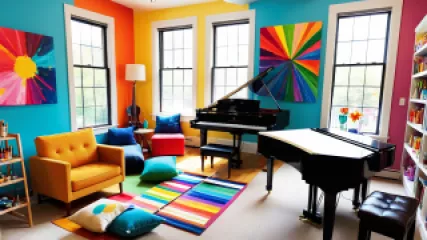The Definitive Guide to Creative Solutions for Mental Health Through Therapy
Mental health has always been a topic of significant importance, and in recent years, there has been a growing recognition of the need for innovative approaches to address mental well-being. One such approach that has garnered considerable attention is creative therapy. Creative therapy encompasses a variety of techniques and methods designed to help individuals express themselves and address mental health challenges through artistic and creative means.
What is Creative Therapy?
Creative therapy refers to a range of therapeutic techniques that draw on the arts to help individuals explore their emotions, develop self-awareness, cope with stress, boost self-esteem, and work on social skills. Unlike traditional talk therapy, creative therapy offers an alternative way to communicate and process feelings when words alone might not suffice.
Types of Creative Therapy
- Art Therapy: This involves using various art forms like drawing, painting, or sculpting to express and explore emotions.
- Music Therapy: Utilizing music to improve mental health, whether through listening, playing instruments, or composing.
- Drama Therapy: Engaging in role-play, storytelling, and acting to explore personal issues and express complex feelings.
- Dance/Movement Therapy: Using physical movement and dance to promote emotional, cognitive, and physical integration.
- Writing Therapy: Encouraging expression through writing, including journaling, poetry, and storytelling.
The Benefits of Creative Therapy
Creative therapy provides numerous benefits for mental health. Here are some key advantages:
- Emotional Expression: It offers a safe space for expressing emotions that may be difficult to articulate verbally.
- Stress Reduction: Engaging in creative activities can significantly reduce stress and anxiety levels.
- Enhanced Self-Awareness: Creative therapy helps individuals gain deeper insights into their thoughts and behaviors.
- Improved Communication: It can enhance communication skills, particularly for those who struggle with verbal expression.
- Healing Trauma: Creative processes can be instrumental in processing and healing from past traumas.
Integrating Creative Therapy into Online Therapy Platforms
With the rise of digital technology, remote creative counseling has become increasingly accessible. Online platforms now offer personal growth workshops and mental health workshops that integrate creative therapeutic approaches. These online sessions provide a flexible and convenient way for individuals to engage in therapy from the comfort of their homes.
Benefits of Online Creative Therapy
- Accessibility: Individuals who have difficulty accessing traditional therapy due to geographical or mobility constraints can benefit greatly.
- Flexibility: Scheduling is often more flexible, making it easier for individuals to fit therapy into their busy lives.
- Comfort: Being in a familiar environment can make therapy less intimidating and more effective.
- Privacy: Online sessions can offer a higher level of privacy and comfort, encouraging openness.
How to Get Started with Creative Therapy
If you're interested in exploring creative solutions for mental health through therapy, here are some steps to get started:
Finding a Qualified Therapist
- Research: Look for therapists who specialize in the type of creative therapy that interests you.
- Credentials: Ensure the therapist is licensed and has the necessary qualifications and experience.
- Consultation: Schedule an initial consultation to discuss your needs and determine if it's a good fit.
Exploring Different Modalities
- Art Therapy: Try different art forms to see which resonates with you the most.
- Music Therapy: Experiment with various musical activities, such as playing instruments or composing.
- Drama Therapy: Engage in role-playing exercises and storytelling.
- Dance/Movement Therapy: Participate in dance or movement sessions.
- Writing Therapy: Start journaling or writing poetry to express your thoughts and feelings.
Success Stories: Real-Life Examples of Creative Therapy
Many individuals have experienced profound transformations through creative therapy. Here are some inspiring success stories:
Robbie Perry's Journey with Art Therapy
"Art therapy helped me uncover emotions I didn't even realize I had. Through painting, I found a way to express my pain and start the healing process." Robbie Perry
Serenity Harris's Experience with Music Therapy
"Playing the piano allowed me to channel my anxiety into something beautiful. Music therapy became my sanctuary." Serenity Harris
Creative Therapy Techniques You Can Try at Home
Even if you're not currently seeing a therapist, you can still explore online therapy for self-expression and try some creative therapy techniques at home:
Art Therapy Activities
- Mandala Coloring: Use mandala coloring books to relax and focus your mind.
- Emotional Drawing: Draw or paint how you feel without worrying about artistic skills.
- Collage Making: Create collages using magazine cutouts to represent your thoughts and feelings.
Music Therapy Exercises
- Listening to Music: Curate playlists that reflect your mood and emotions.
- Playing Instruments: Learn to play an instrument or practice one you already know.
- Songwriting: Write lyrics or compose music to express your experiences.
Writing Therapy Practices
- Journaling: Keep a daily journal to document your thoughts and feelings.
- Poetry Writing: Write poems that capture your emotions and experiences.
- Storytelling: Create short stories or fictional narratives based on your life events.
Challenges and Considerations in Creative Therapy
While creative therapy offers many benefits, there are also some challenges and considerations to keep in mind:
Overcoming Initial Hesitation
Many individuals may feel hesitant or self-conscious about engaging in creative activities, especially if they don't consider themselves "artistic." It's important to remember that the goal of creative therapy is not to produce masterpieces but to explore and express emotions.
Finding the Right Fit
Not all creative modalities will resonate with everyone. It's crucial to experiment with different forms of creative therapy to find what works best for you.
Balancing Creativity and Structure
While creativity is encouraged, it's also essential to have some structure in the therapeutic process to ensure progress and avoid feeling overwhelmed.
The Future of Creative Therapy
The field of creative therapy is continuously evolving, and its potential is vast. With advancements in technology and a growing understanding of the mind-body connection, creative therapy is poised to become an integral part of holistic mental health care.
Integration with Technology
Virtual reality (VR) and augmented reality (AR) are emerging as powerful tools in creative therapy. These technologies can create immersive experiences that enhance therapeutic outcomes.
Expanding Access
As awareness of creative therapy grows, efforts are being made to expand access to diverse populations, including underserved communities and individuals with disabilities.
Collaborative Approaches
Integrating creative therapy with other therapeutic modalities, such as cognitive-behavioral therapy (CBT) and mindfulness, can create comprehensive treatment plans tailored to individual needs.
Conclusion: Embracing Creativity for Mental Health
Creative therapy offers a unique and powerful way to address mental health challenges. By engaging in creative solutions for mental health, individuals can unlock new pathways to healing and personal growth. Whether through art, music, drama, dance, or writing, creative therapy provides a valuable toolkit for self-expression and emotional well-being.
As we continue to explore and embrace these innovative approaches, the future of mental health care looks promising, offering hope and healing to countless individuals around the world.






